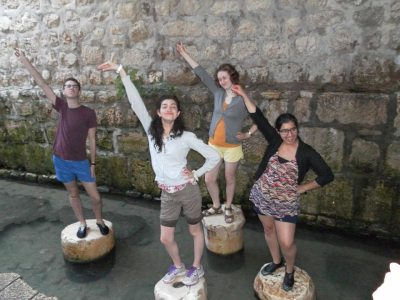We visited the City of David and went through Hezekiah’s Tunnel. For the Christians, David is a direct descendent of Jesus, while for Jews he is the father of Israel. A young shepherd boy from the tribe of Judah who slays the giant Goliath from the enemy Philistine tribe, is then elevated to king of Judah, unites the two kingdoms and expands Israel into a powerful empire.
The National Geographic “Kings of Controversy” article shows the discussion of different archaeologists talking about their theories and their evidence to support it. On King David, Robert Draper states: “He has persisted for three millennia—an omnipresence in art, folklore, churches, and census rolls. To Muslims, he is Daoud, the venerated emperor and servant of Allah. To Christians, he is the natural and spiritual ancestor of Jesus, who thereby inherits David’s messianic mantle. To the Jews, he is the father of Israel—the shepherd king anointed by God—and they in turn are his descendants and God’s Chosen People. That he might be something lesser, or a myth altogether, is to many unthinkable.”
Our guide Danny, an archaeologist himself was saying how the Bible gives places like this context: and how without it, it would be nothing but walls and pottery shards. This secular Zionist perspective looks for proof that important events recorded in the Bible happened here. This makes David’s conquest and unification of Israel—fulfilling God’s promise to Abraham—therefore a way of legitimizing the state. Though I don’t expect the Bible to be precise in history by any means, a lot of knowledge can be taken from its traditions and stories. The site itself really felt like a very established tourism place, more than the other sites we had visited.
After going through the supposed ruins of King David’s palace, we made our way to Hezekiah’s Tunnel. The story goes that in preparation for the attack on Jerusalem from the Assyrian king Sennacharib, King Hezekiah ordered a tunnel to be excavated in order for the besieged city to have access to water. This story is recorded in the books of Chronicles and Kings. The result is a winding tunnel over 500 meters long that connected the spring to the Siloam pool underneath and across the city.
Two teams excavated the tunnel from each side—it winds around, the two sides trying to meet in the middle. We know they went in two directions because of the change in direction of the pickaxes. Halfway through, at the same level, there is an inscription describing the moment the two sides met:
And this was the account of the breakthrough. While the laborers were still working with their picks, each toward the other, and while there were still three cubits to be broken through, the voice of each was heard calling to the other, because there was a zdh [perhaps “split,” “crack” or “overlap”] in the rock to the south and to the north. And at the moment of the breakthrough, the laborers struck each toward the other, pick against pick. Then the water flowed from the spring to the pool for 1200 cubits. And the height of the rock above the heads of the laborers was 100 cubits.
I can only imagine the cheers of the teams having met in the middle. I’m so glad that I ended up going through the tunnel, as I was worried that I’d find it claustrophobic. As I was getting used to the shocking temperature of the water sometimes going up above my knees, I kept my hand near my head so as not to hit it against the top of the tunnel, which would rise and fall. Once our group had finally made it through, we posed on the rocks of the nearby pool victoriously, wet pants and all.
Natalia Pochtaruk
